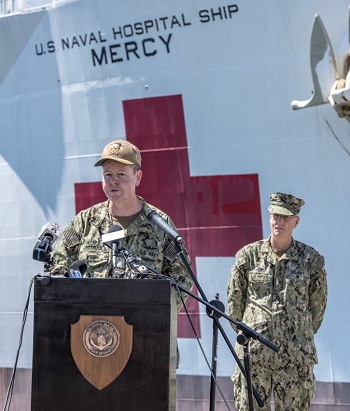 Navy Capt. John Rotruck, then the commanding officer of the USNS Mercy, speaks to members of the press before the ship departed Naval Base San Diego in March. Mercy deployed in support of the nation’s COVID-19 response efforts, serving as a referral hospital for non-COVID-19 patients admitted to shore-based hospitals. (Photo by Navy Communication Specialist 1st Class David Mora Jr.)
Navy Capt. John Rotruck, then the commanding officer of the USNS Mercy, speaks to members of the press before the ship departed Naval Base San Diego in March. Mercy deployed in support of the nation’s COVID-19 response efforts, serving as a referral hospital for non-COVID-19 patients admitted to shore-based hospitals. (Photo by Navy Communication Specialist 1st Class David Mora Jr.)
Before his current duty station, he was the military medical treatment facility commanding officer on the hospital ship USNS Mercy, which made port in Los Angeles to serve as a relief valve for civilian hospitals so the city’s health professionals could focus on the COVID-19 cases that were overwhelming the city. The Mercy’s mission was considered defense support of civil authorities, and was led by the Federal Emergency Management Agency.
“MTF and civilian mariners instituted aggressive COVID mitigation measures early on,” Rotruck recalled. This included compliance with the Department of Defense mandatory mask policy, and hand-washing and social distancing whenever possible.
“As we began to experience a few cases amongst the crew, we took aggressive efforts to complete contact tracing and test and quarantine any close contacts, to include exit quarantine testing,” Rotruck said.
The DOD published more than a dozen force health protection guidance documents in 2020, covering many areas to minimize the risk of COVID-19 spread within the U.S. Military. This includes guidance for testing, travel, face coverings, re-integrating individuals who recovered from COVID-19 back into their units, proper use of personal protective equipment (PPE), how to assess risks at MTFs, and more.
“Installation commanders follow local public health guidance and make sure we have a well-informed force, as evidenced by the behavior they’ve exhibited throughout this pandemic,” said Lernes Hebert, deputy assistant secretary of defense for military personnel policy, at a July press briefing at the Pentagon.
In California, the Mercy had some tricky logistical maneuvering to do, moving many crew members to single hotel rooms off-ship. A tent was set up on the flight deck to provide additional social distancing during meals.
Those measures, though unique to this particular Navy hospital ship, were consistent with triage systems used at MTFs. Under the guidance of public health officers, these systems separated patients with suspected COVID-19 exposure from other patients and providers. Additionally, in the early days of the pandemic, the MHS paused elective and non-essential procedures at MTFs, limiting exposure risk and preserving PPE for COVID-19 patients.
Rotruck said the Mercy was fortunate to have an infectious diseases physician aboard, “with whom we continually consulted. Naval Medical Forces Pacific also deployed a Navy Environmental Health and Preventive Medicine Unit detachment with us, who conducted all of our COVID testing and oversaw our contact tracing.”
All the support was “invaluable” for maintaining the crew’s health, he said.
Meanwhile, Rotruck’s new unit in Japan is keeping an eye on the COVID-19 situation within several populations.
“As you can imagine, force readiness through force health and preservation is our top priority, so we maintain our ability to respond to crisis,” he said. “We continue to monitor COVID closely both within our [status of forces agreement] population and in the local community, and adjust our force health protection posture accordingly, to maintain that force readiness.”